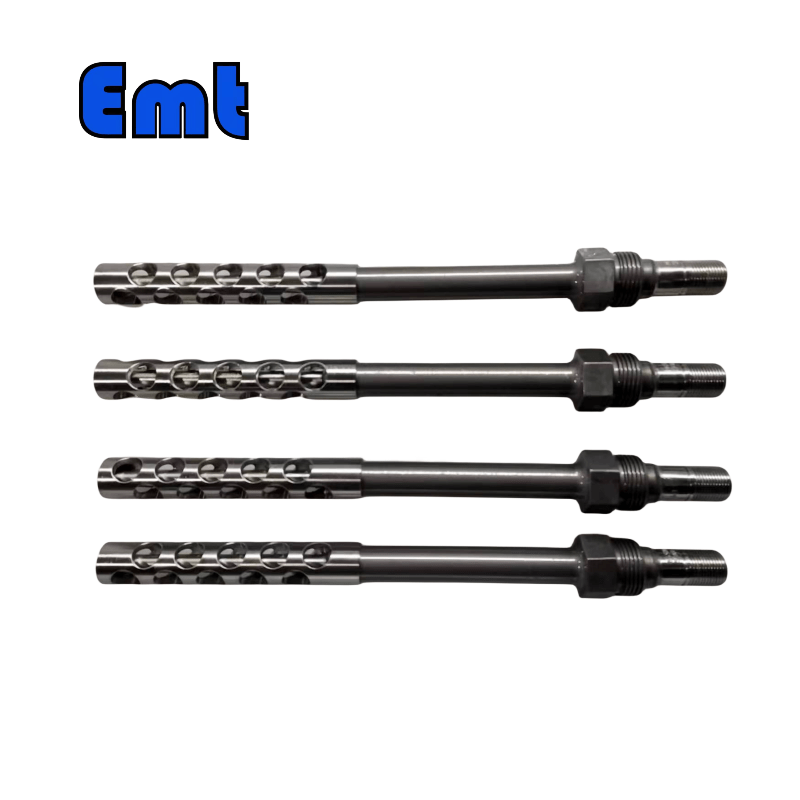Description
| Name | EMT-CP ER Corrosion Probe | |
| Material | Stainless Steel 316、L DUPLEX SS | |
| Operating Temperature | -20~200℃ | |
| Feature | 1. Easy Operating | |
| 2. High Accuracy Long Life | ||
| 3. High Efficiency Low cost | ||
| Payment | TT/LC | |
| Advantage | 1. Firstly, they are lightweight and flexible. | |
| 2. Then, nice injection efficiency. | ||
| 3. At last, accurate location tracking |
Metal Material: 316、L DUPLEX SS
Sealing Material: Teflon or Fluororubber
Working Temperature: -20~200℃
Working Pressure: 0~26 MPa
Access Fitting Body and Protective Cover :
Size of Flange : ANSI 2″ RF (or RJ)
Material : CS 、316L、 DUPLEX SS
Working Pressure: 0~26MPa
Working Temperature: -20~200℃

1. Introduction
The resistance ER probe has two kinds: tubular probes and flat probes. Introduce it as follows: Tubular probes are made from thin-walled, small tubes fabricated from material obtained onsite. Tubular probes possess high sensitivity and accuracy, making them suitable for environments with pressures not exceeding 50 MPa.
So the Electrical Resistance (ER) probe, is a cornerstone in the world of corrosion monitoring. It is a special device to measure and monitor the rate of corrosion within a particular system. Then, it operates on the fundamental principle that as metal corrodes, the cross-sectional area of the metal decreases. Which in turn leads to an increase in electrical resistance. This correlation between corrosion rate and electrical resistance also provides a quantifiable method to monitor and manage corrosion in a variety of industrial applications.
2. Components of ER Probe
The ER probe typically has several elements. The sensing element, or ‘heart’ of the probe, is a crucial component made from the same material as the system being monitored. This identical material composition ensures that the sensing element will experience the same corrosive environment and undergo similar corrosion processes as the system. The sensing element is connected to the measurement system via electrical connections, which are insulated to prevent any erroneous readings or electrical interference.
3. Working of ER Probe
The sensing element and the electrical connections are housed in a protective body, typically made of a corrosion-resistant material. This protective body shields the internal components from the harsh external environment while allowing the sensing element to be exposed to the corrosive conditions within the system. Meticulously craft the design and construction of the ER probe to ensure accurate, reliable, and continuous measurements, even in the most aggressive and corrosive environments.
4. Advantages of ER Probe
One of the standout features of ER probes is their ability to measure electrical resistance changes over time, providing a time-dependent corrosion rate. By monitoring these changes, operators can gain an understanding of the severity of the corrosive conditions within a system. The level of corrosion detected can then inform decisions regarding necessary maintenance activities, the effectiveness of corrosion inhibitors, or the need for system upgrades or replacements.
Furthermore, ER probes have the added advantage of providing real-time, continuous monitoring of corrosion rates. This means that operators can have immediate access to data, enabling them to respond promptly to changing conditions, such as sudden increases in corrosion rates. This real-time data can be invaluable in preventing catastrophic failures, reducing downtime, and optimizing maintenance schedules.
5. Applications of ER Probe
ER probes find their applications in a variety of industries. In the oil and gas industry, for example, ER probes work to monitor corrosion in pipelines and storage tanks. Given the corrosive nature of many oil and gas products, understanding the corrosion rates can be vital in preventing leaks and ensuring the integrity of the infrastructure.
In the water treatment industry, ER probes work to monitor the corrosiveness of water. By ensuring that the water is not overly corrosive, the longevity of pipes and pumps can be extended, and the quality of the water can be maintained.
In the chemical processing industry, ER probes are employed similarly to monitor and manage corrosion rates in reactors, storage tanks, and pipelines. With many chemical processes involving corrosive substances, ER probes can provide essential data to maintain system integrity and safety.
6. Conclusion
In conclusion, ER probes represent a critical tool in the management and control of corrosion. Their ability to provide real-time, quantifiable data on corrosion rates makes them invaluable in a multitude of industries. Through their use, companies can ensure the longevity and safety of their infrastructure, optimize their maintenance schedules, and ultimately, save time and resources.
1. Many kinds of chemical injection with different types to meet different requirements.
2. The fastest feedback!
3. Also the fastest delivery time.
4. 24 hours,7 days online.

 We use PLYWOOD CASE as packaging, it has the following advantages:
We use PLYWOOD CASE as packaging, it has the following advantages:
1. Light-weight, clear lines, insulation, high strength, not easy to deformation;
2. Then no fumigation required.



Reviews
There are no reviews yet.